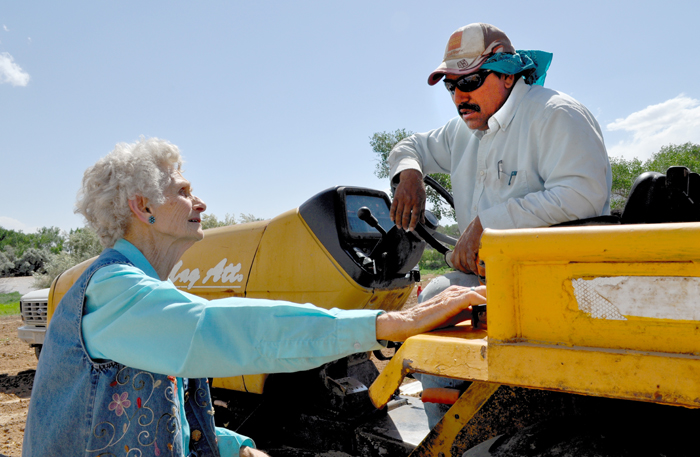
Before Interstate 70 opened in 1970, Nancy Dunham’s children would haul their Red Flyer wagon filled with homegrown pumpkins to sell along the highway that ran through Green River. “That’s how it started,” the 86-year old Dunham Farms matriarch recalls. The kids soon started growing watermelons, and now Dunham Farms is one of three major melon farms in town, known for its award-winning fruit.
Nancy and her husband, Gene, moved to Green River during the uranium boom of the 1950s, and there, with their six children, the family started to put down roots in the community. Nancy’s son, Chris, now manages Dunham Farms’ 200-plus riverside acres, but Nancy’s decades of connection to the land and its seasonal cycles makes her not only a melon-growing authority, but also an intimate observer of the plant species and its relationship to the community.
Seated in her farmhouse decorated with a colorful mixture of multicultural and family keepsakes, Nancy’s turquoise shirt highlights her bright blue eyes. Kindness defines her appearance as she talks about life and melons.
“You can feel the soil and tell when it’s warm enough to plant,” says the slender storyteller, who also enjoys connecting to the earth by walking barefoot on the land. Nancy has a college degree in agriculture and talks just as comfortably about diploid seeds as well as the energetic frequency of melon plants.
Planting happens in May, and watermelon is the majority of seed sown. “The soil here is a remarkable blessing,” Nancy says of Green River’s favorable growing conditions. The Dunhams also grow other popular varieties including cantaloupe, Crenshaws, and others. “One day I counted 17 different kinds of melons being sold at our stand,” she recounts.
To stand in a field alive with flowering melon plants, Nancy shares, is a magical experience. The interval from flower to fruit is just six weeks, and then harvest begins. “That E flat thing about knowing when a melon is ripe? That’s just talk. You find the tendril and little leaf closest to the melon, and when that’s dry, it’s ripe,” she explains.

And Dunham melons are divine. “People from Grand Junction will drive here just to have melons for breakfast,” she mentions. In one of Nancy’s many scrapbooks brimming with newspaper clippings and photos is a letter in which the writer recounts the Dunham melon he’d eaten 63 years before, and then asks if it were possible to have some shipped to him in South Carolina.
Nancy also possesses a wealth of information about the plant’s other uses. Watermelons, she points out, are high in lycopene, a cancer preventative, and watermelon seed tea is purported to support kidney health. People carve the skin into fanciful artwork, make jellies and jams, “and with all that beautiful rind,” Nancy explains, “you can make salsas and relishes.” The seeds as well can be roasted and eaten. “We tried yellow watermelon wine once,” she remembers, “but the melons didn’t have a high enough sugar content.” In lieu of a birthday cake one year, Nancy presented a table of children with a watermelon ablaze with sparklers she’d poked into the rind. “I kind of ruined the tablecloth,” she laughs.
The annual September Melon Days mark the height of Green River’s harvest, and the town celebrates with a parade and festivities. In the Dunham’s melon stand building, there is a poster-sized frame filled with individual photos of worldwide customers posing in their Watermelon Days t-shirts at various locations around the globe. In fact, Nancy says the best part about growing and selling melons is the people. “Melons,” Nancy beams, “just make people happy.”


